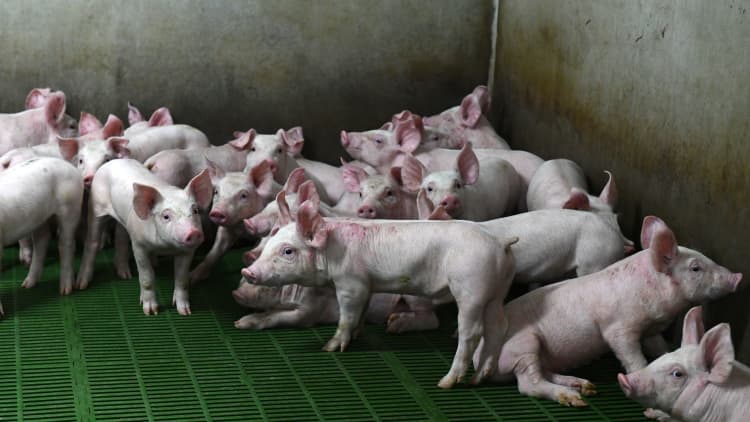U.K. pork exporters are forecasting high demand from China to continue into 2020 after the country was hit particularly hard by a virus that has been killing pigs around the world.
Pork is by far the most popular meat in China, but domestic producers have been hit hard by African Swine Fever (ASF).
Beijing authorities said Monday that efforts to stabilize prices have achieved results. China has been drawing down on its frozen pork inventories as well as fast-tracking trade deals to raise the level of imports.
In the first eight months of 2019, Britain shipped more than 45,000 metric tons of pork to China according to industry press, almost double 2018 volumes. This has made China the U.K.'s biggest customer of pig meat.
In the last few month, six new U.K. plants have approved to export pig trotters, a popular Chinese delicacy.
The U.K.'s biggest pork producer, Tulip, generates more than £1 billion ($1.34 bn) in total revenue each year. For China, Tulip primarily exports pig heads, trotters, hind feet and offal. Belly, back and shoulder are also shipped.
Agricultural Director at Tulip, Andrew Saunders, told CNBC in an email Friday that its abattoirs that export to China have had an increase in sales of around 80% year on year.
Saunders added that said Chinese demand growth had been happening since August 2018 and China had now witnessed a 25% reduction of its domestic pork production due to ASF.
On whether the high prices are likely to persist Saunders said: "We expect this to continue into 2020."
In November, rival U.K. processor Cranswick reported a 7.1% rise in six-month revenue "underpinned by a very strong performance in our Far East export markets."
It added that ASF in Far East export markets had "created the opportunity to increase sales into this region on commercially favorable term."
Chinese pork demand typically peaks in late January around the celebration of the Lunar New Year. Fears exist that China won't have enough pig meat to satisfy demand next year.
But commodity specialists at Rabobank have seen signs that the Chinese consumer was prepared to avoid pork if the prices were too high. It said in June that Chinese pork consumption had dropped by 10% to 15% across 2019, driven by food safety concerns.
It noted that while lowering pork consumption and the release of healthy frozen pork had restricted rises to Chinese pork and hog prices, other substitute meats prices were on the rise.
Rabobank said Chinese canteens at schools or factories had switched to poultry and chicken breast meat prices had risen by 44% year on year by May. The bank forecasts that for 2020, there will be less pork produced but other markets such as beef and chicken will grow.
Now watch: US pork prices surge on Chinese demand



